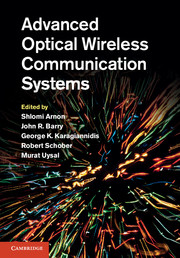1 - Introduction
from Part I - Outlook
Published online by Cambridge University Press: 05 June 2012
Summary
Optical wireless communication is an emerging and dynamic research and development area that has generated a vast number of interesting solutions to very complicated communication challenges. For example, high data rate, high capacity and minimum interference links for short-range communication for inter-building communication, computer-to-computer communication, or sensor networks. At the opposite extreme is a long-range link in the order of millions of kilometers in the new mission to Mars and other solar system planets. It is important to mention that optical wireless communication is one of the oldest methods that humanity has used for communication. In prehistoric times humans used fire and smoke to communicate; later in history, Roman optical heliographs and Sumerians signalling towers were the communication systems of these empires. An analogous technology was used by Napoleonic Signalling Towers and “recently” by the light photo-phone of Alexander Graham Bell back in the 1880s.
Obviously, the data rate, quality of service delivered, and transceiver technologies employed have improved greatly from those early optical wireless technologies. In its many applications, optical wireless communication links have already succeeded in becoming part of our everyday lives at our homes and offices. Optical wireless products are already well familiar, ranging from visible-light communication (VLC), TV remote control to IrDA ports that currently have a worldwide installed base of hundreds of million of units with tens of percent annual growth. Optical wireless is also widely available on personal computers, peripherals, embedded systems and devices of all types, terrestrial and in-building optical wireless LANs, network of sensors, and inter-satellite link applications.
- Type
- Chapter
- Information
- Advanced Optical Wireless Communication Systems , pp. 3 - 8Publisher: Cambridge University PressPrint publication year: 2012

